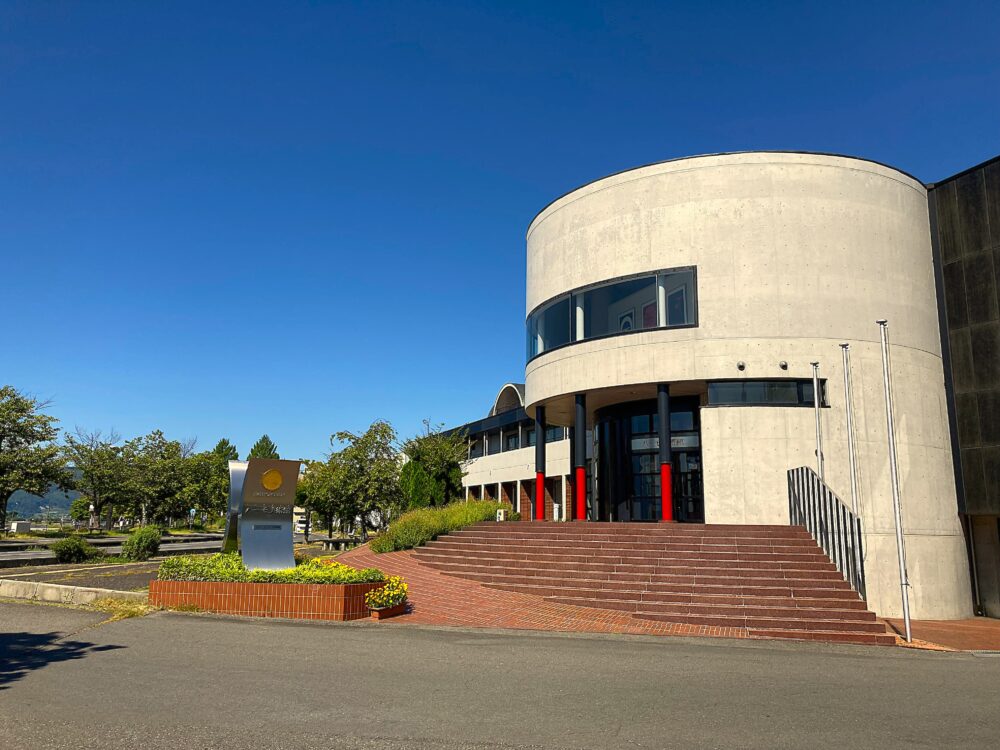
Harmo Museum of Art: Where Nature and Art Come Together at Lake Suwa
Located on the shores of Lake Suwa in central Nagano, the Harmo Museum of Art is a unique spot where you can enjoy art surrounded by mountains and water. Even though the area is a popular tourist destination, the museum itself feels calm and almost like a hidden retreat.
Opened in April 1990, the museum was founded by Tomio Hama, the creator of the industrial robot company Harmo Co., Ltd., together with director Takako Seki. Their concept was “Art and Simplicity.” True to that vision, the museum’s core collection focuses on works by Naïve artists (also called Peintres Naïfs).
A stroll along Lake Suwa is already relaxing, but stepping inside the museum offers something even more special—a quiet space where you can leave the noise of the city behind and spend time face-to-face with art.
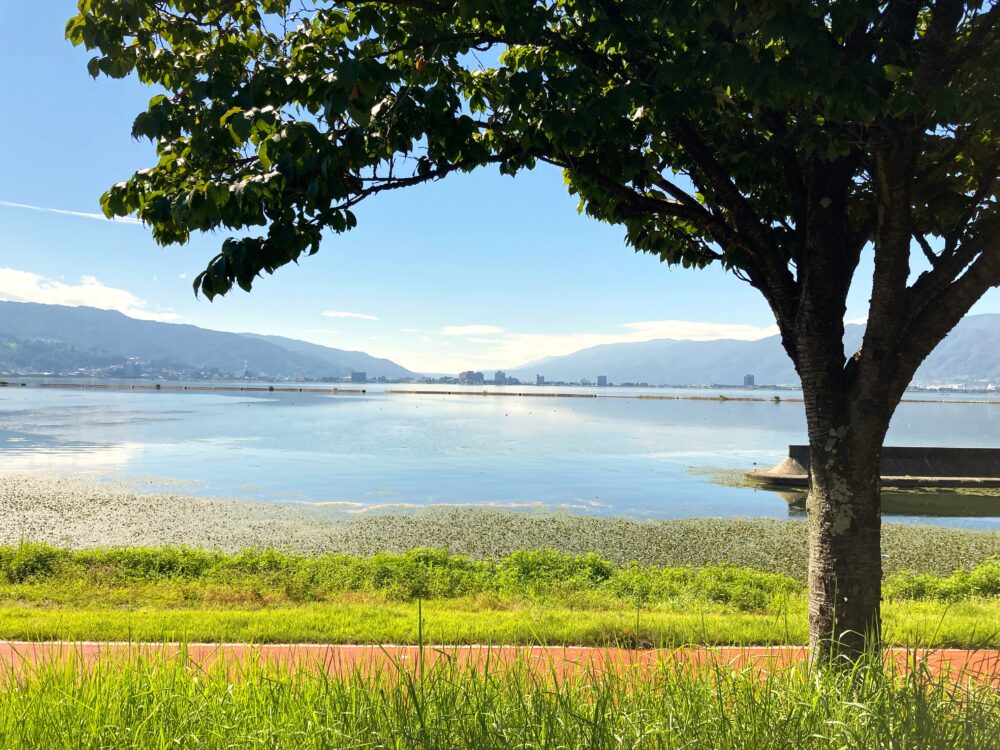
From Rousseau to Bauchant: Highlights of Naïve Art
The Harmo Museum of Art also displays works by 20th-century masters such as Salvador Dalí, Marc Chagall, Henri Matisse, and Georges Rouault. But what truly sets this museum apart is its outstanding collection of Naïve Art, centered around Henri Rousseau.
Here you’ll find pieces by André Bauchant, Camille Bombois, Louis Vivin, and other leading figures of the movement. Their paintings open up a free-spirited, unpretentious world where you can simply enjoy art without needing complicated theories. That’s the true charm of Naïve Art—it speaks directly to your senses.
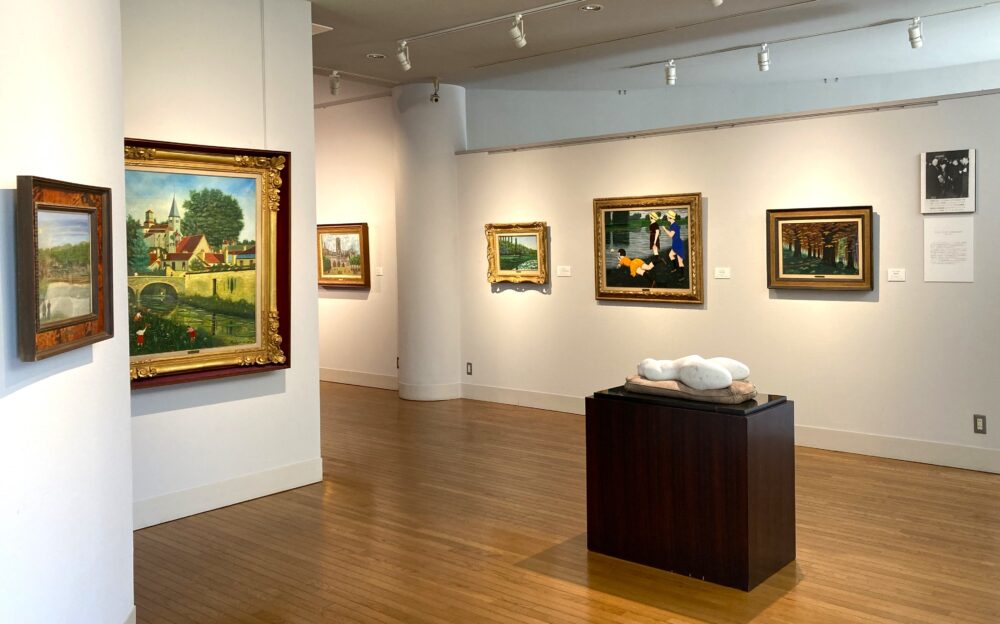
A Perfect Spot for a Relaxing Day Trip
With Lake Suwa’s natural beauty outside and warm, heartfelt paintings inside, the Harmo Museum of Art is an ideal destination for a weekend getaway. Even if you don’t know much about art, the free and honest expressions of the Naïve painters will give you a sense of peace and fulfillment.
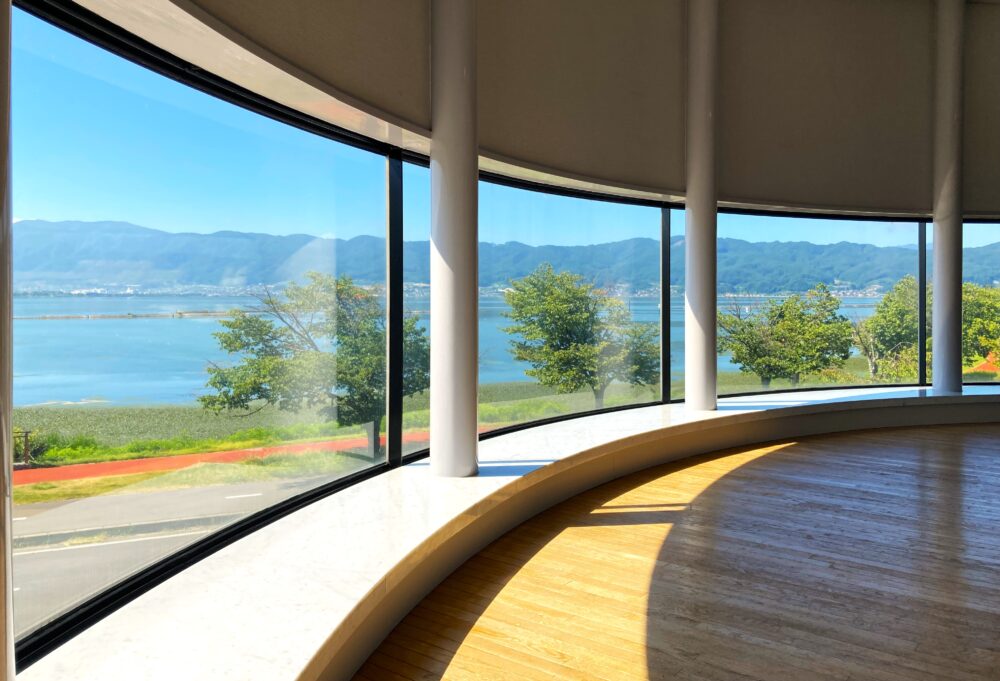
Who Was Henri Rousseau, the Icon of Naïve Art?
When people talk about Naïve Art, the first name that usually comes up is Henri Rousseau (full name: Henri Julien Félix Rousseau). But who exactly was he?
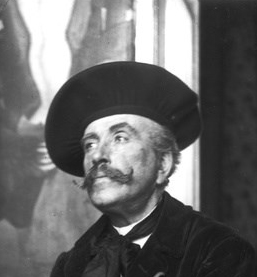
Surprisingly, Rousseau wasn’t a professional artist from the start. He actually worked as a customs officer in Paris and never received formal art training. It wasn’t until his 40s that he began painting seriously—earning him the reputation of a “Sunday painter” turned artist.
At first glance, Rousseau’s style looks like something no one else could imitate. But interestingly, his inspiration came from classical art rather than the trends of his time. While Impressionism, Fauvism, and Cubism were on the rise, Rousseau preferred studying Old Masters, copying works at the Louvre, and learning from academic painters.
However, his unconventional style didn’t fit the traditional Salon exhibitions of the day. Instead, he found his stage at the Salon des Indépendants—an open exhibition where anyone could display their work without jury approval.
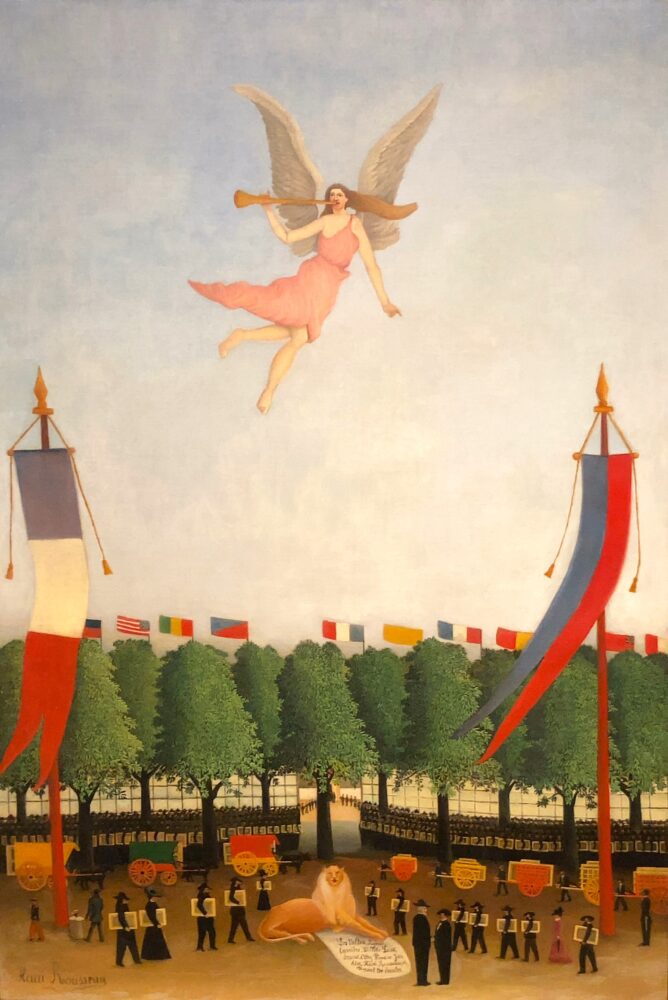
“Liberty Inviting Artists to Take Part in the 22nd Exhibition of the Société des Artistes Indépendants”
(1905-1906)
His first appearance there was in 1894, and from then until his death, Rousseau continued to submit works almost every year. For him, the chance to simply have people see his art was powerful motivation.
Recognition didn’t come until late in his life. For many years, critics mocked his paintings. Yet Rousseau kept going—not to please the critics, but simply because he wanted to paint. That honest, straightforward attitude is at the heart of his appeal.
His works are free from rigid theories or academic rules. He painted everyday scenes and vivid images from his imagination just as they appeared to him. And that is exactly why his art feels so genuine and continues to move viewers even today.
Now, let’s take a look at some of Rousseau’s works—and other Naïve Art pieces—that you can encounter at the Harmo Museum of Art.
Naïve Art at the Harmo Museum of Art
Please note: Some works may not be on view due to special exhibitions or rotation.
Henri Rousseau
“Banks Of The Marne (also known as Autumn, View Of Damery-Boursault)” (1906)
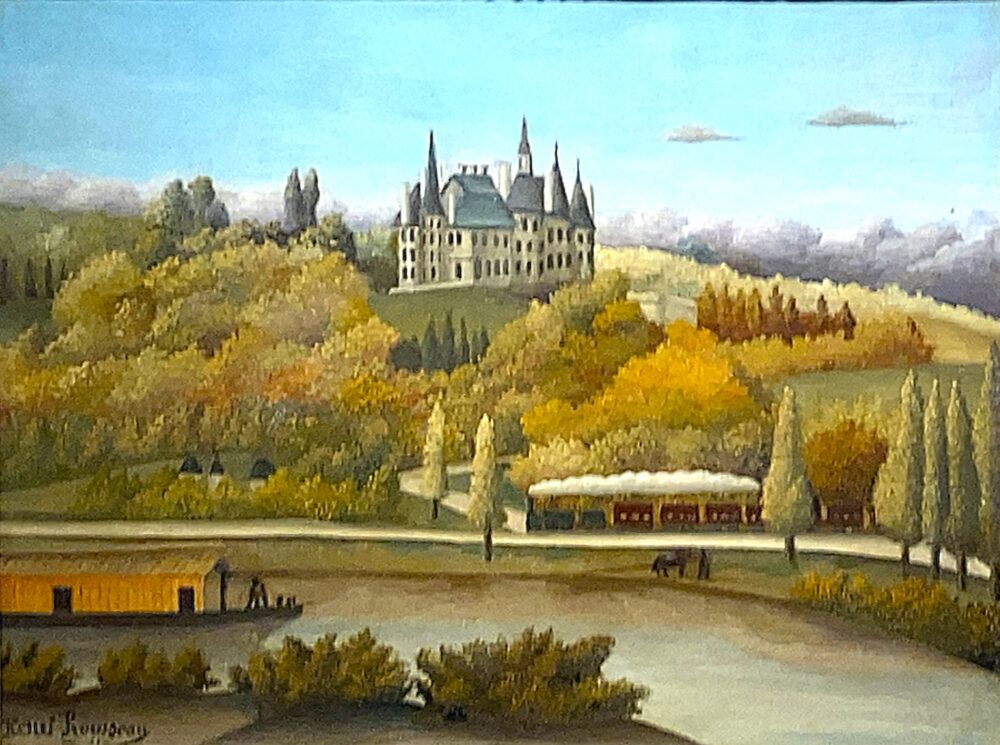
About This Work (Tap or Click to View)
This painting was shown at the 23rd Salon des Indépendants in 1907. Under a bright blue sky, golden autumn trees stand out vividly. With a passing train, a small boat, and winding paths, the scene feels almost like a miniature diorama—quiet and comforting at the same time.
Unusually for Rousseau, the perspective in this piece is relatively well organized. For that reason, art historians believe he may have based it on a postcard.
The landscape shows the town of Damery, northeast of Paris, looking across the Marne River toward Boursault. At the center of the canvas stands the Château de Boursault, which still exists today and is now used as a Champagne winery.
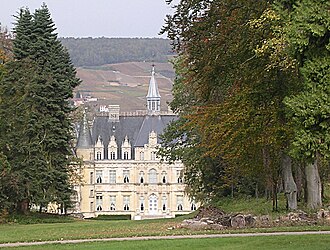
img: by User:Denys
Interestingly, this painting had already been sold before it was even exhibited. While critics of the time often dismissed Rousseau, major artists such as Picasso, Gauguin, and Toulouse-Lautrec deeply admired him. Picasso, in particular, once discovered one of Rousseau’s works in an antique shop and immediately added it to his own collection.
Henri Rousseau
“Landscape with a Fisherman” (c.1886)
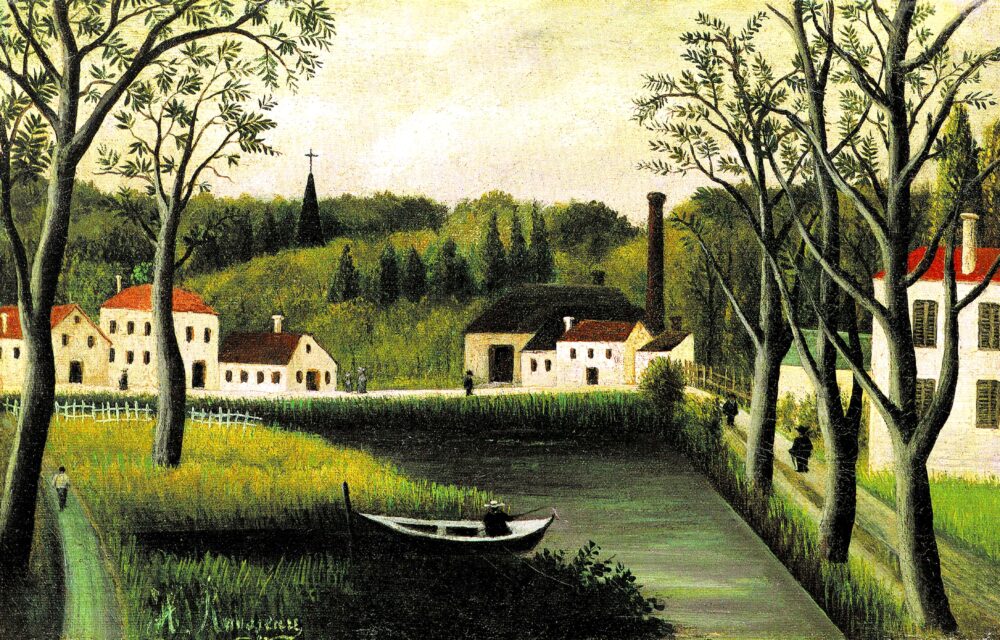
About This Work (Tap or Click to View)
What stands out in this piece is the way each leaf in the foreground trees is carefully painted, almost as if Rousseau was simply enjoying the act of painting itself.
In the distance, the trees are shaded with soft green gradations, while the flatly painted houses pop with blocks of color. Look closer and you’ll notice charming details: a rough wooden fence across the grass, and a tiny church spire far away on the horizon. These touches are classic Rousseau.
Rousseau painted this around the time he was still working as a Paris customs officer. He wouldn’t devote himself fully to art until after 1893; before that, he painted only during his free time, essentially as a “Sunday painter.”
And while the title of “customs officer” might sound prestigious, the job was actually demanding—collecting taxes from merchants and farmers, sometimes on grueling 24-hour shifts. For Rousseau, the hours spent at the easel must have been his greatest source of relief and joy.
Henri Rousseau
“Flowers” (1910)
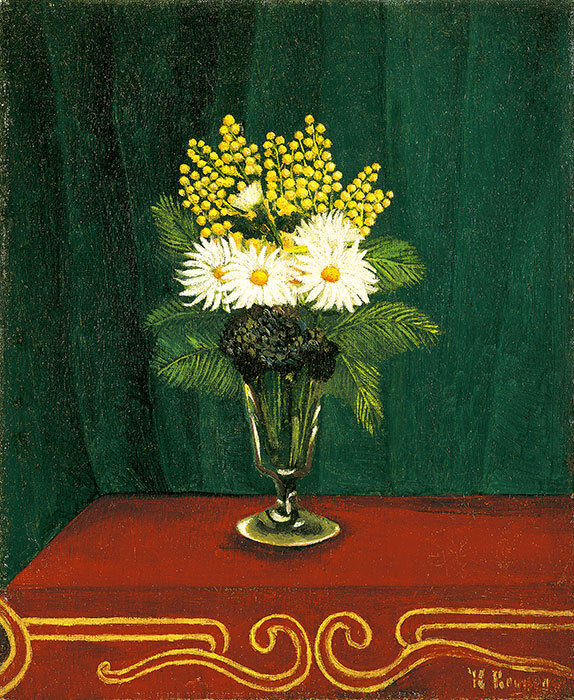
About This Work (Tap or Click to View)
When people think of Rousseau, they often picture his famous jungles or landscapes. But he also painted flowers. Only a little more than twenty such works are known, making this still life a rare and special part of his art. One of those precious pieces is kept right here at the Harmo Museum of Art.
This painting shows marguerites and mimosa. The red table and green background create a bold contrast, yet the bouquet in the glass pulls the whole scene together. Look closely and you’ll see every marguerite faces forward, adding a playful charm. It even recalls how Rousseau painted most of his portraits—figures staring straight at the viewer. The result is a work full of the simple, honest style that makes Rousseau so beloved.
Rousseau created this canvas in 1910, the same year he passed away from illness. By then, his art was finally gaining recognition and finding buyers. Thinking about what more he might have created if he had lived longer leaves a bittersweet feeling.
André Bauchant
“Flowers and Birds” (1958)
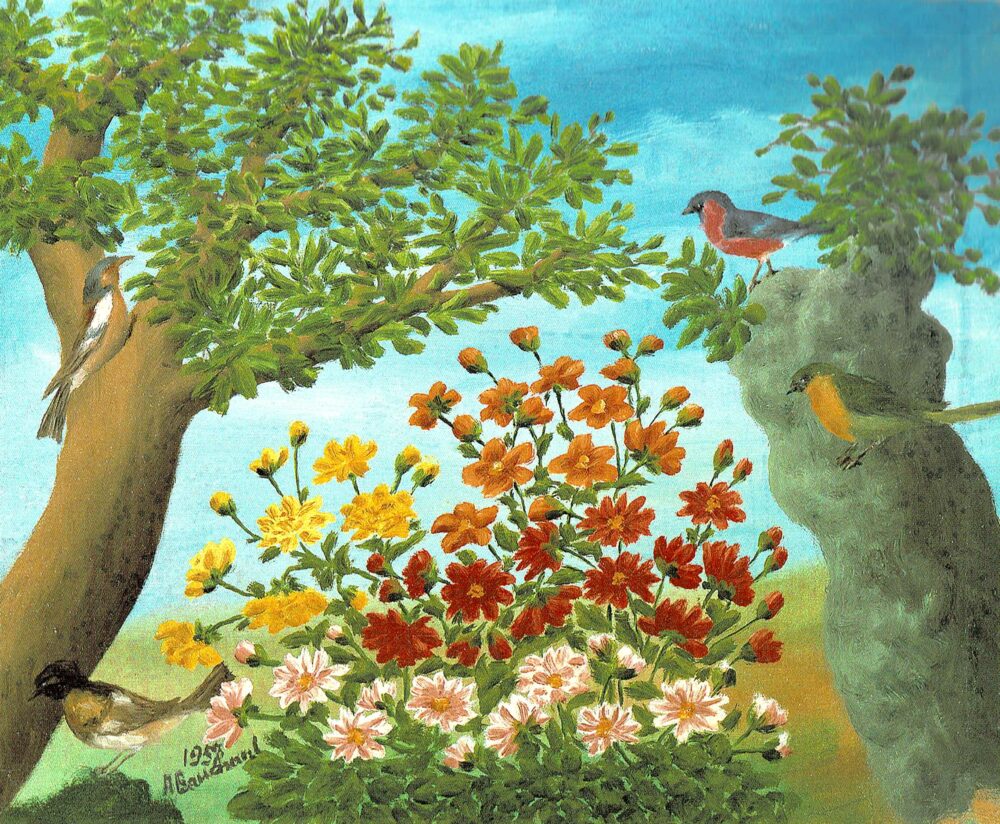
About This Work (Tap or Click to View)
The Harmo Museum of Art holds many works by naïve painters besides Rousseau. One of them is André Bauchant (1873–1958).
Bauchant was also from France and, like Rousseau, he began painting in oil only after the age of forty. His path is similar to Rousseau’s, who devoted himself fully to art later in life.
Before becoming a painter, Bauchant worked as a gardener. During World War I, he was assigned to drafting maps, and his precision surprised his superiors. This experience is said to have sparked his interest in painting.
Flowers and Birds was created at the very end of Bauchant’s life, when he was 85 years old. True to his gardening background, he often painted plants, flowers, and birds. This canvas captures that charm perfectly. Its simple, flowing brushstrokes suggest that Bauchant continued to find joy in painting nature until his final years.
Louis Vivin
“The Church“
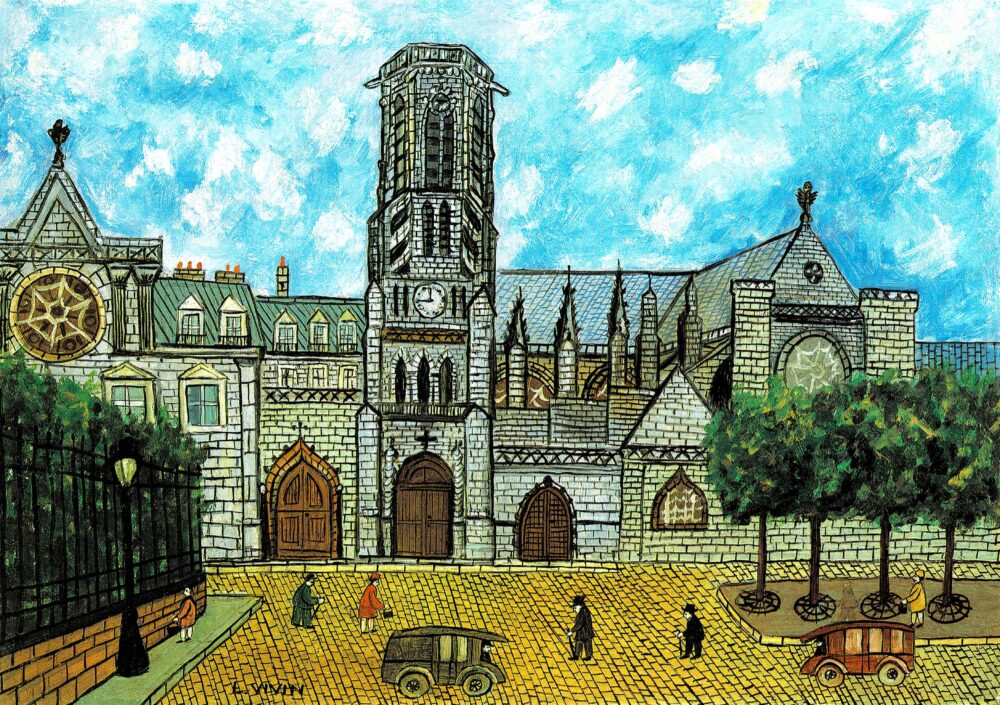
About This Work (Tap or Click to View)
Louis Vivin (1861–1936) began painting seriously only after leaving his job at the Paris post office. He was born in the Vosges region of eastern France and later spent the rest of his life in Paris.
A striking feature of Vivin’s art is his use of bold black outlines. When painting buildings, he carefully detailed every brick and cobblestone, almost as if dissecting the structure itself.
This style can be traced back to his background—he studied at a technical school, and his fascination with construction and design found its way onto the canvas.
Unlike the soft, playful touch of Rousseau or Bauchant, Vivin’s paintings radiate a different charm. They reveal not only his deep affection for architecture but also his love for the streets and scenery of Paris.
Other Works by Louis Vivin at the Harmo Museum of Art
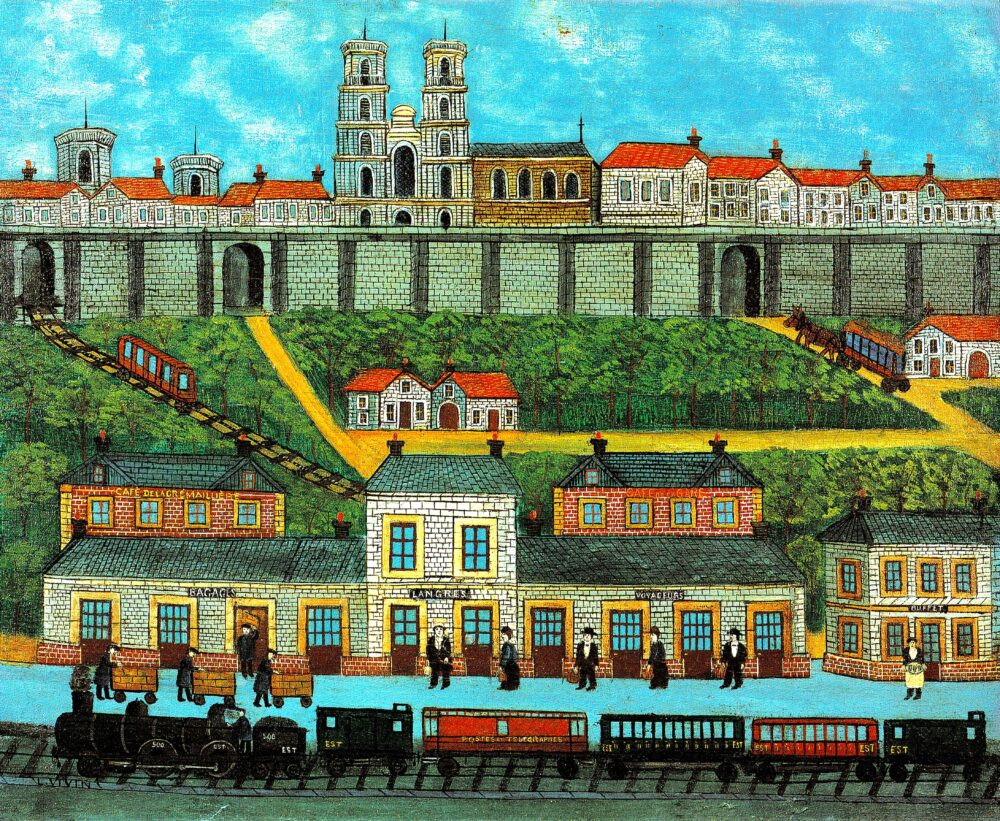
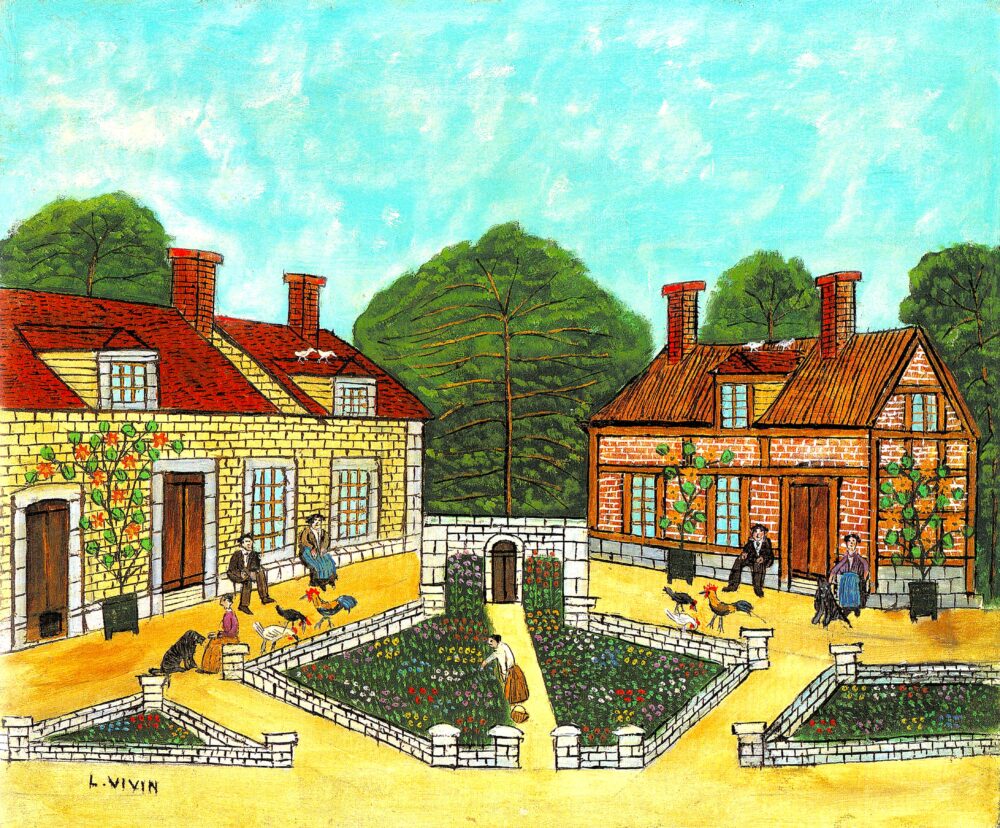
Conclusion
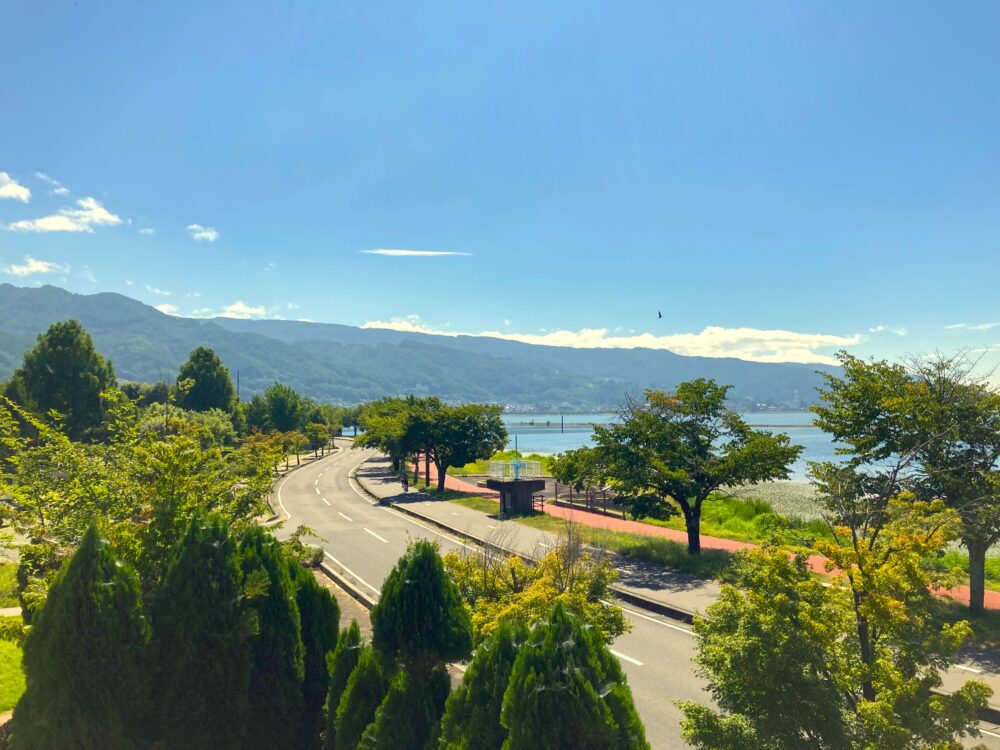
In this article, we introduced the Harmo Museum of Art, a unique museum surrounded by the calm beauty of Lake Suwa in Nagano.
Japan has many distinctive museums, but the Harmo Museum stands out for its concept of “Art and Simplicity.” The natural scenery of Lake Suwa blends beautifully with the works of naïve painters such as Henri Rousseau, André Bauchant, and Louis Vivin, creating a relaxing space to enjoy art.
What these artists share in common is that they began painting seriously later in life. Their pure desire to “just paint” became the driving force behind their creativity. This honesty and simplicity are at the heart of naïve art.
Rather than focusing on theory or technique, they painted familiar landscapes, beloved objects, and everyday scenes. Because of that, their works continue to touch people’s hearts today.
Even if you come with the simple thought of “I’d like to enjoy some art,” the Harmo Museum of Art will give you a rewarding experience. Why not plan a visit on your next trip to Lake Suwa?
Harmo Museum of Art – Visitor Information
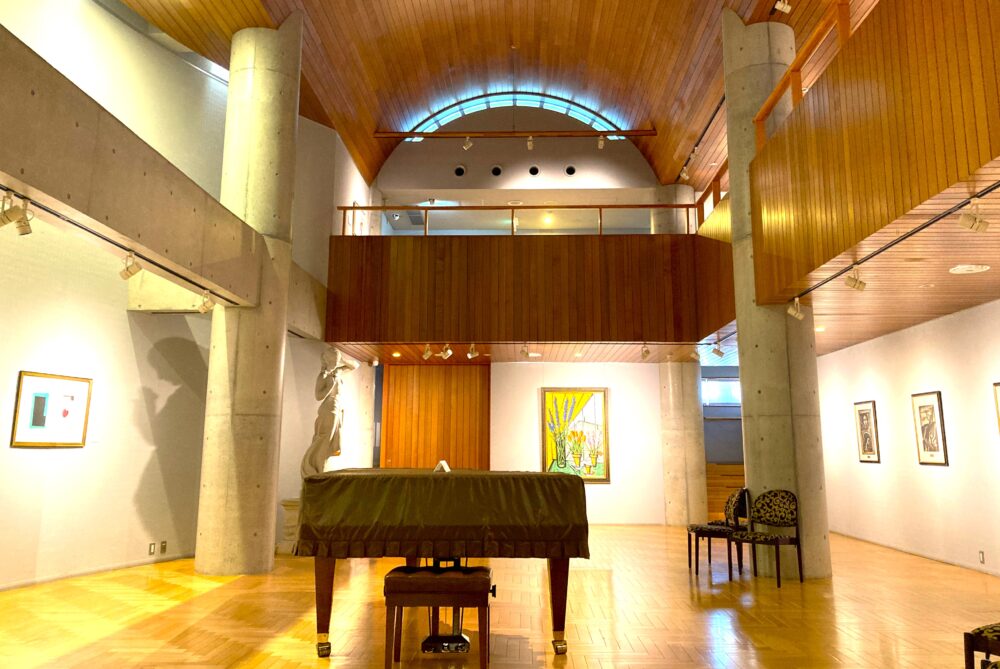
Location: 10616-540 Shimosuwa, Suwa District, Nagano Prefecture, Japan
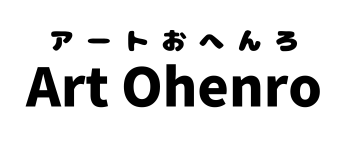



Comments